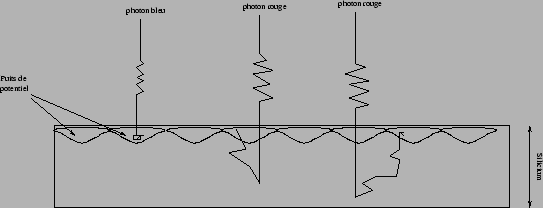Contents
The tools for photometry of HuPhot were built by using the algorithms described in naylor1998. They apply equation 8.4 that we derived higher.
To apply, these methods we used PSFs synthetic produced by the TinyTim
software. This software makes it possible to simulate the PSF of a star
according to:
- The CCD considered, and the position in this one (the size of the pixels or the distortions varies according to the CCD).
- The filter of observation, in particular, PSFs are
narrower in ultraviolet ray than in the visible filters holtzman199ä.
Indeed, the spreading out of the PSF is mainly with diffraction by the
instrument, diffraction will be more significant with big wavelength. A
second phenomenon spreads out in a significant way the PSF: diffusion
of the electrons in the adjacent pixels. CCDs of the WFPC2 are lit by
the front one, the blue photons will thus interact in silicon earlier
and thus closer to the zone of collection of the electrons (Figure 8.8 ). The diffusion of the electrons towards the adjacent pixels and the spreading out of the PSF will be thus less significant.
- The spectrum of the object (which has a minor influence in practice).
Figure 8.8: Interaction of
the photons in a CCD lit by the front one. We represented a blue photon
whose interaction is done early and thus near to the zone of capture of
the electrons and two red photons whose interaction takes place major
in silicon. For those, the probability of deriving towards the adjacent
wells of potential (corresponding to the adjacent pixels) is thus more
significant. The diffusion is thus more significant in the red. In the
case of a CCD lit by the back, the zone of capture of the electrons is
in bottom of silicon. In fact the blue photons then will be diffused.
 |
We thus simulated for each filter used for the observation of our supernovæ , a series of PSFs to cover all the field of camera PC (a PSF was built all the 50 pixels in each direction).
The TinyTim software produces two types of PSF:
- Of PSFs to the normal pixelisation centered on the medium of the pixel.
- Of PSFs suréchantillonées up to 10 times.
We thus chose to use PSFs oversampled so as to be able to align
the grid of pixels of the PSF in the most precise possible way on the
grid of pixels of data.
Sub-sections
Contents Julien Raux 2004-05-04

